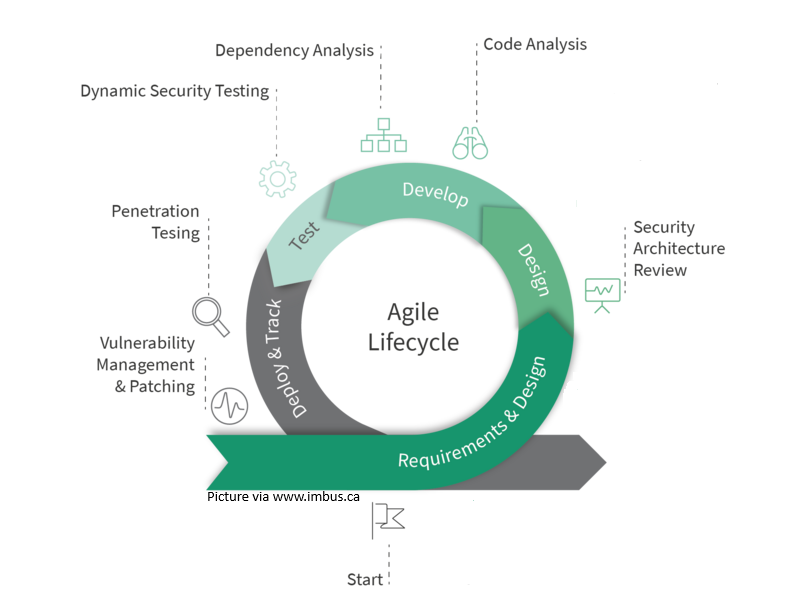
In today’s rapidly evolving digital landscape, security risks are growing just as quickly as emerging technologies and their applications. Often overlooked or delayed in favor of faster development and deployment, integrating security testing during the software development life cycle (SDLC) may not always be a priority for Agile development teams.
This article explores how to effectively incorporate security testing into the SDLC while leveraging Agile methodology, highlighting the benefits it brings to software products and organizations alike.
Understanding security testing
What: Security testing assesses software to identify vulnerabilities that could be exploited by malicious actors. This process ensures that the software is resilient against real-world threats, safeguards user and company data, maintains functionality, and complies with relevant security standards and regulations.
When: Security testing should be performed proactively, with results promptly addressed, to identify and resolve vulnerabilities before attackers can exploit them.
The importance of security testing in the SDLC
Drawing a comparison between manual functional testers and security testers provides a strong foundation for understanding the critical role of Security Testing in the Software Development Life Cycle (SDLC).
When a Test Engineer or QA team member is integrated into an Agile development team from the outset of a project, their involvement across all stages – from Requirements & Design to Deploy & Track – significantly enhances project quality. This early integration ensures that functional and non-functional issues are identified and resolved promptly, leading to fewer bugs and a smoother live deployment.
The same principle applies to Security Testing. Including a Security Test Engineer from the beginning of the development process greatly reduces the likelihood of security issues at deployment. Here are several reasons why embedding security testing early in Agile projects is vital:
- Early Vulnerability Detection: By conducting security testing early in the SDLC, vulnerabilities are identified and mitigated before they escalate into critical issues. This proactive approach minimizes the resources and time required to address security flaws later in the development process.
- Compliance and Risk Management: Security testing ensures compliance with stringent data protection regulations, reducing legal risks and safeguarding the organization’s reputation, trust, and credibility.
- Improved Product Quality: Beyond safeguarding against cyber threats, security testing enhances the overall product quality. Addressing security flaws bolsters the application’s reliability and efficiency.
- Cost Efficiency: Identifying and resolving security flaws during the early stages of development is significantly more cost-effective than addressing issues after deployment or later in the SDLC.
Integrating security testing early and throughout the agile development process is a proactive measure that leads to secure, high-quality software and long-term cost savings.
Integrating security testing in SDLC phases
Now that we’ve explored the importance of integrating security testing into the Software Development Life Cycle (SDLC), let’s examine how to implement this effectively in practice. Below is a phase-by-phase guide to embedding security testing, forming a robust framework for secure software development:
Requirements & Design Phase
- Define security requirements and objectives early.
- Identify potential threats and vulnerabilities that may impact the software.
Design Phase
- Integrate security best practices into the design process.
- Anticipate potential security issues to address them proactively.
Development Phase
- Follow secure coding practices.
- Perform regular code reviews and static code analysis to detect vulnerabilities during development.
Testing Phase
- Implement Dynamic Application Security Testing (DAST): Simulate real-world attacks on the application’s front-end to identify vulnerabilities by analyzing unexpected outcomes. This approach evaluates the application from an external perspective, mimicking a malicious user’s actions.
- Conduct Manual Penetration Testing: Identify and address vulnerabilities through hands-on simulated attacks.
- Perform Security Regression Testing: Verify that new changes do not introduce new vulnerabilities.
- Automate testing processes to streamline and continuously monitor security assessments.
Deployment Phase
- Run a Penetration Testing session before live deployment to identify exploitable vulnerabilities through simulated cyberattacks.
- Conduct additional activities like:
- Vulnerability Assessment
- Configuration Management
- Access Control Testing
Maintenance Phase
- Continuously monitor the software for new security threats.
- Perform: Regular Security Audits, User Access Reviews, and Security Training to keep teams updated on evolving threats.
By incorporating security testing into each phase of the SDLC, organizations can proactively address vulnerabilities, maintain compliance, and deliver robust, secure software.

The consequences of neglecting security testing
Let’s consider a scenario: what happens when security testing is overlooked, and a product is deployed with major vulnerabilities?
Imagine the fallout: users’ trust is shattered when their data is leaked, and the company’s reputation takes a severe hit. What about the financial losses or the operational disruption caused by a security breach? Neglecting security can have dire consequences, not just for the software but also for the organization and its customers.
Here are some examples of breaches exploited by hackers and their devastating effects:
- Massive Financial Losses: The largest recorded finncial loss from a cyber-attack occurred with Equifax, which suffered an estimated $1.4 billion in damages. Numerous companies have faced similar financial repercussions, demonstrating the critical need for robust security measures.
- Data Breaches: A significant example is the CAM4 Data Breach in March 2020, where over 10 billion user records from the adult webcam streaming platform were exposed. Compromised information included full names, sexual orientations, chat transcripts, payment logs, IP addresses, and more putting users at extreme risk.
- Business Bankruptcy: ome organizations never recover from a cyber-attack. For example, Code Spaces was forced to shut down permanently following an attack it could not resolve.
Neglecting security testing doesn’t just lead to technical issues; it can result in irreversible damage to a company’s finances, reputation, and even its ability to operate.
Final thoughts
Integrating security testing into the SDLC is crucial for creating secure and reliable software, rather than relying on trial and error in a live environment, which comes with significant risks.
By addressing security concerns early and continuously throughout the development process, organizations can safeguard their applications against potential threats, ensure compliance with regulations, and deliver high-quality software to their users.